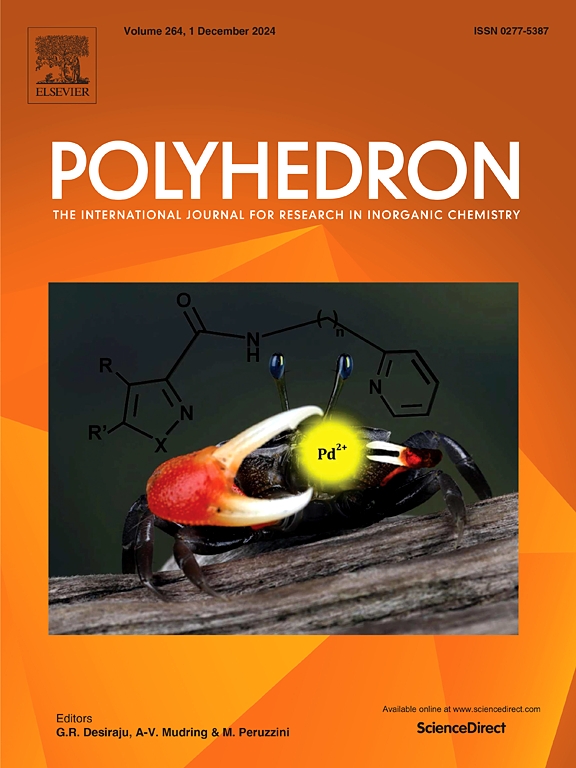通过无水前驱体策略获得的上转化LiYF4:Yb3+, Tm3+纳米颗粒具有非常稳定的发光测温性能
IF 2.4
3区 化学
Q2 CHEMISTRY, INORGANIC & NUCLEAR
引用次数: 0
摘要
由于其优异的光学性能,含镧纳米材料正迅速成为高灵敏度测温的有希望的候选材料。本文描述了用自制的无水前驱体[Ln(TFA)3(单lyme)]和[Li(TFA)(单lyme)] (Ln = Y, Tm, Yb;TFA =三氟乙酸酯)在热注射法。这些NPs表现出优异的恒定相对灵敏度(>1%.K−1)和在宽温度范围(300-500 K)内的稳定性,表明它们是需要宽温度范围的温度传感应用的良好候选者。此外,还研究了n -甲基取代氨基醇存在下Gd(TFA)3(H2O)3和Li(TFA)(H2O)之间的反应,以及它们作为基于LiGdF4基质的上转化纳米颗粒前驱体的作用。其中一个反应分离出同金属簇[Gd4(OH)4(TFA)8(mdeaH2)3(THF)]。2 THF (1, mdeaH2 = n -甲基二乙醇胺),结构表征。讨论了锂和三氟乙酸钆热/微波共分解制备LiGdF4 NPs的难点。本文章由计算机程序翻译,如有差异,请以英文原文为准。
Remarkably stable luminescence thermometric performance of upconverting LiYF4:Yb3+, Tm3+ nanoparticles obtained via an anhydrous precursor strategy
Given their excellent optical properties, the lanthanide-containing nanomaterials are fast emerging as promising candidates for highly sensitive thermometry. This work describes the thermometric performance of high quality tetragonal LiYF4: Yb3+, Tm3+ NPs synthesized using home-made anhydrous precursors [Ln(TFA)3(monoglyme)] and [Li(TFA)(monoglyme)] (Ln = Y, Tm, Yb; TFA = trifluoroacetate) in a hot-injection method. These NPs show excellent constant relative sensitivity (>1%.K−1) and stability over a wide range of temperature (300–500 K), indicating that they are good candidates for temperature-sensing applications requiring a wide range of temperature. In addition, reactions between Gd(TFA)3(H2O)3 and Li(TFA)(H2O) in the presence of N-methyl substituted amino alcohols were also investigated in relation with their use as precursors for LiGdF4 matrix-based upconverting nanoparticles. One of these reactions resulted in the isolation of a homometallic cluster [Gd4(OH)4(TFA)8(mdeaH2)3(THF)]. 2 THF (1, mdeaH2 = N-methyl diethanolamine), which was structurally characterized. The difficulty in getting LiGdF4 NPs from the thermal/microwave co-decomposition of lithium and gadolinium trifluoroacetates are discussed.
求助全文
通过发布文献求助,成功后即可免费获取论文全文。
去求助
来源期刊

Polyhedron
化学-晶体学
CiteScore
4.90
自引率
7.70%
发文量
515
审稿时长
2 months
期刊介绍:
Polyhedron publishes original, fundamental, experimental and theoretical work of the highest quality in all the major areas of inorganic chemistry. This includes synthetic chemistry, coordination chemistry, organometallic chemistry, bioinorganic chemistry, and solid-state and materials chemistry.
Papers should be significant pieces of work, and all new compounds must be appropriately characterized. The inclusion of single-crystal X-ray structural data is strongly encouraged, but papers reporting only the X-ray structure determination of a single compound will usually not be considered. Papers on solid-state or materials chemistry will be expected to have a significant molecular chemistry component (such as the synthesis and characterization of the molecular precursors and/or a systematic study of the use of different precursors or reaction conditions) or demonstrate a cutting-edge application (for example inorganic materials for energy applications). Papers dealing only with stability constants are not considered.
 求助内容:
求助内容: 应助结果提醒方式:
应助结果提醒方式:


